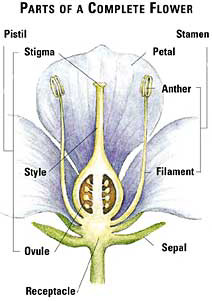|
|
Sepals make up the outer ring of floral parts; collectively, they are called the calyx. They are often green in color, though some flowers (like the fuchsia) have brightly coloured sepals that look like petals. Petals form the next circle of flower parts, just in from the sepals. Petals may be separate, like in a rose, or united in a tubular, cupped, or bell-like shape, as in a petunia. Collectively, the petals are called the corolla; corolla and calyx together are known as the perianth. Stamens, just in from the petals, contain the male reproductive elements. A typical stamen consists of a slender stalk, the filament, topped by an anther, which is usually yellow in color. The anther contains grains of pollen, the male element needed to fertilize the flower.
|
|
Pistils, found in the flower's center, bear the female reproductive parts. Each pistil typically consists of an ovary with a stalklike tube (the style) rising from it. The style is topped by a stigma, which receives the pollen. The ovary contains one or more ovules; after pollination and fertilization, these develop into the plant's seeds. |
|
